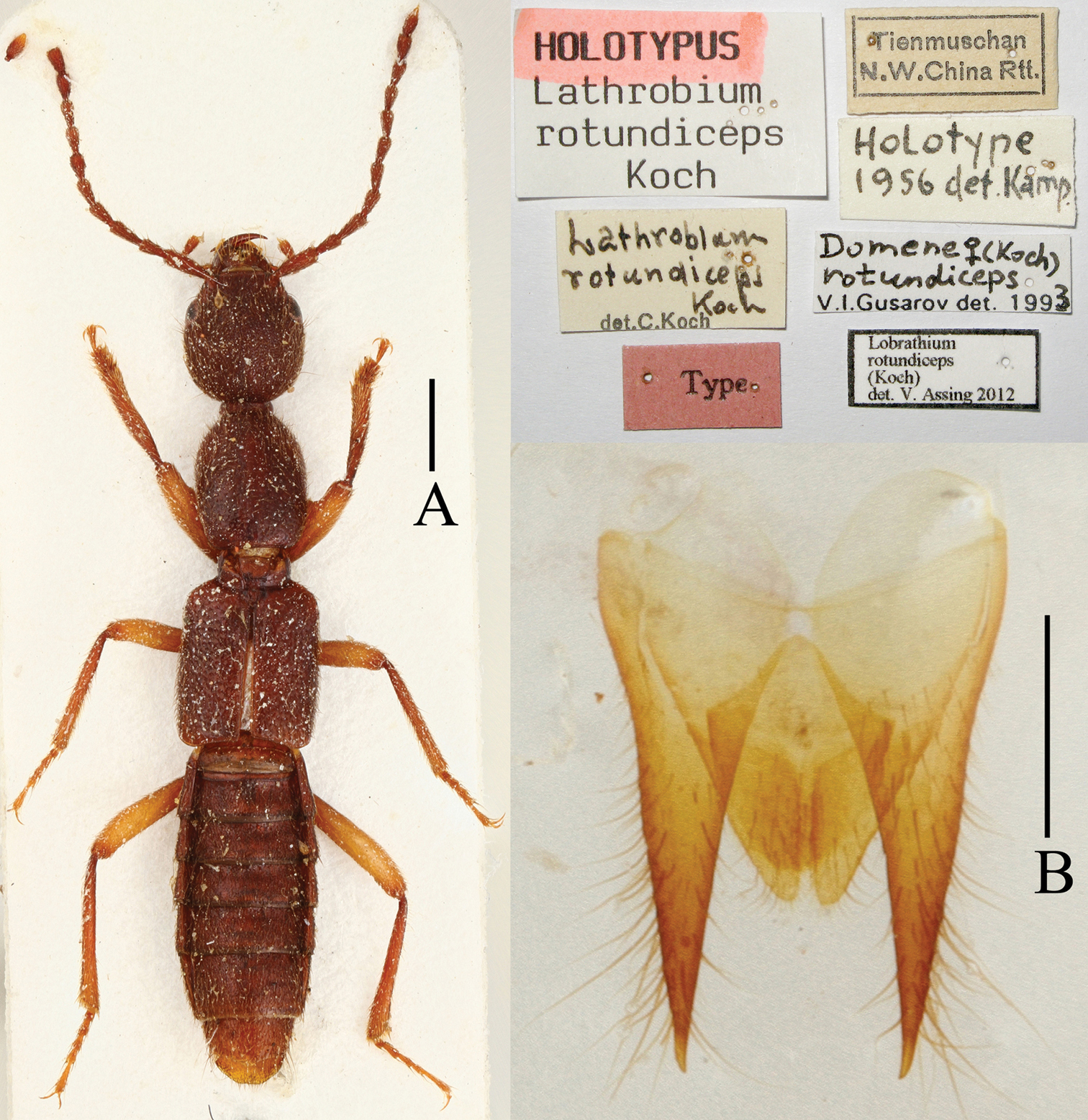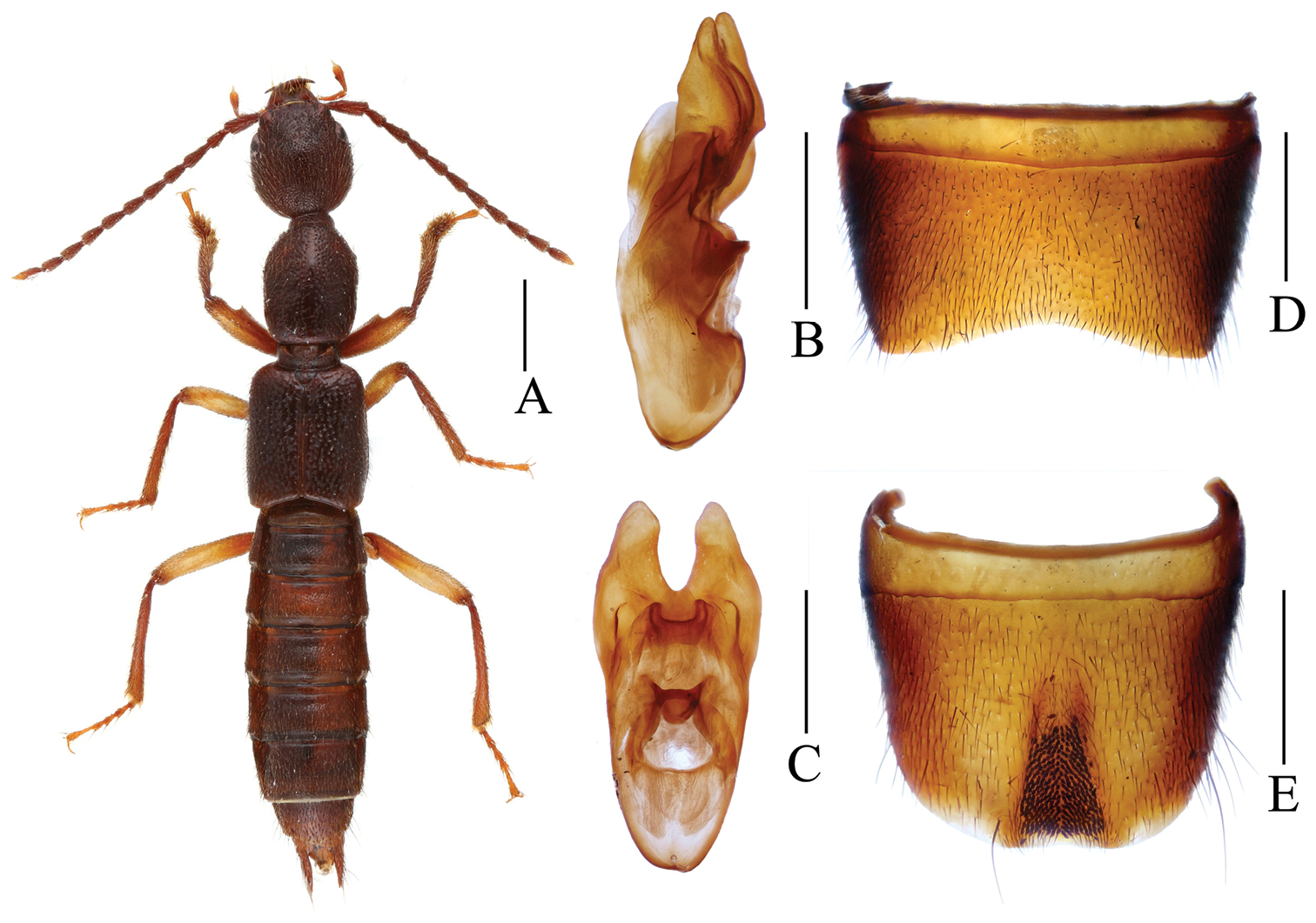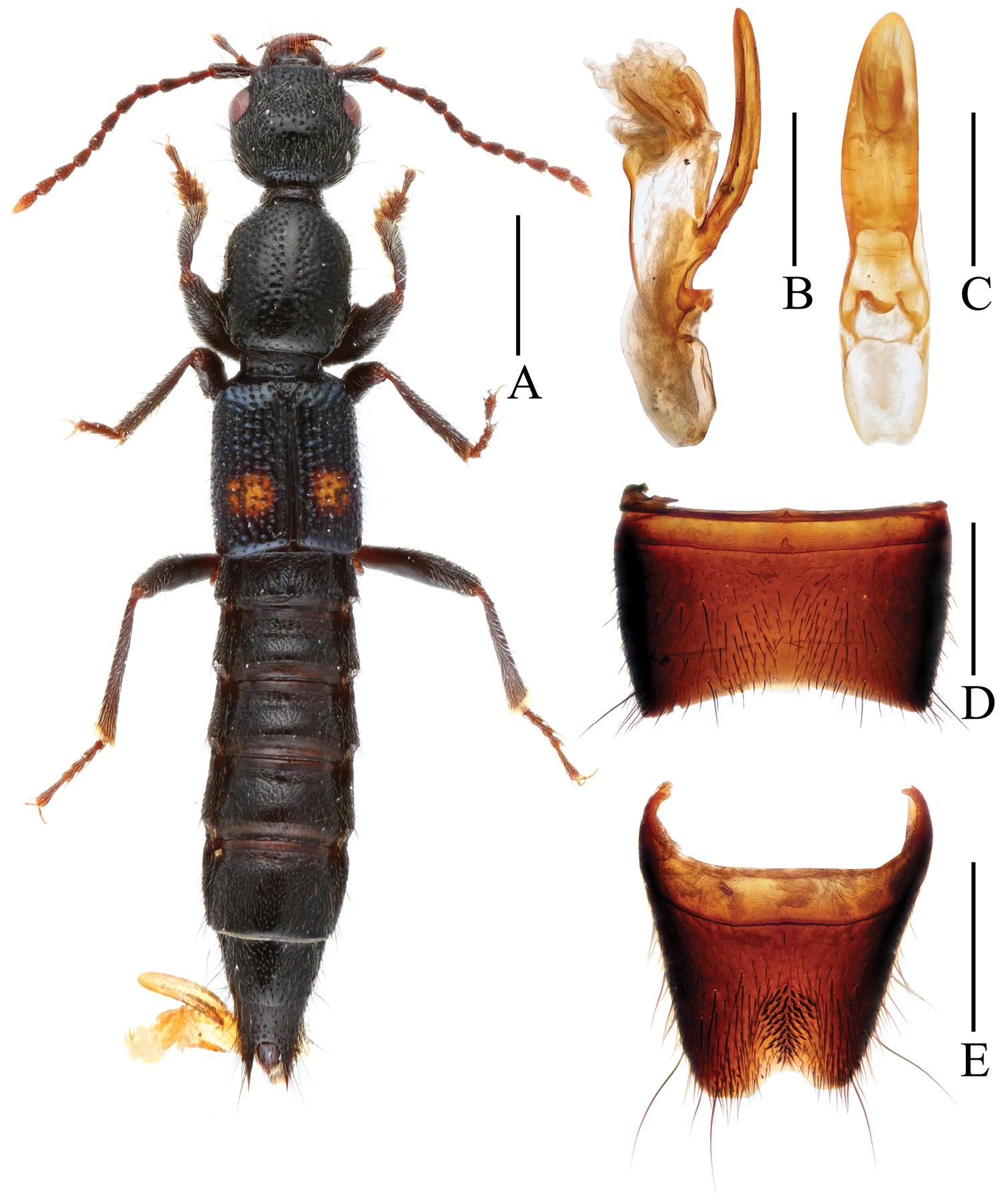






(C) 2013 Wen-Rong Li. This is an open access article distributed under the terms of the Creative Commons Attribution License 3.0 (CC-BY), which permits unrestricted use, distribution, and reproduction in any medium, provided the original author and source are credited.
For reference, use of the paginated PDF or printed version of this article is recommended.
Citation: Li W-R, Li L-Z (2013) Discovery of the male of Lobrathium rotundiceps (Koch), and a new species of Lobrathium from Jiangxi, East China (Coleoptera, Staphylinidae, Paederinae). ZooKeys 348: 89–95. doi: 10.3897/zookeys.348.6299
The male of Lobrathium rotundiceps (Koch, 1939) from Zhejiang and L. luoxiaoense sp. n. from Jiangxi are described and illustrated.
Lobrathium rotundiceps, taxonomy, male, new species, China
Lobrathium rotundiceps was described by
In July 2013, two colleagues sifted two specimens of an undescribed Lobrathium in Jiangxi.
The specimens treated in this study are deposited in the following public collections: The Insect Collection of Shanghai Normal University, Shanghai, P. R. China (SNUC); Naturhistorisches Museum Basel, Switzerland (NHMB).
The labels of type specimens are cited in their original spelling. A slash (/) is used to separate different labels.
All measurements are in millimeters. The following abbreviations are used: BL–length of the body from the anterior margin of the mandibles (in resting position) to the abdominal apex; HL–length of the head from the anterior margin of the frons to the posterior margin of the head; HW–maximum width of the head; PL–length of the pronotum along the midline; PW–maximum width of the pronotum; EL–length of the elytra from the anterior margin to the posterior elytral margin along suture; EW–maximum width of the elytra; AL–length of the aedeagus from the apex of the ventral process to the base of the aedeagal capsule.
http://species-id.net/wiki/Lobrathium_rotundiceps
Figs 1, 2Holotype ♀: “Tienmuschan, N.W. China Rtt. / Type / Lathrobium rotundiceps Koch, det. C. Koch / Holotypus 1956, det. Kamp / Holotypus Lathrobium rotundiceps Koch / Domene rotundiceps (Koch) ♀, V.I. Gusarov det. 1993 / Lobrathium rotundiceps (Koch), det.
Lobrathium rotundiceps, holotype. A habitus B female tergites IX–X. Scales: A 1 mm, B 0.5 mm.
China, Zhejiang (12 ♂♂, 1 ♀): 3 ♂♂, Lin’an City, Tianmu Shan, 800–1150 m, 19–V–2006, Hu & Tang leg.; 5 ♂♂, Anji City, Longwang Shan, Qianmutian 4.8 km, 1050–1250 m, 08–VI–2012, Hu & Yin leg.; 4 ♂♂, Longwang Shan, Qianmutian, 1300 m, 29–V–2009, Yuan et al. leg.; 1 ♀, Longwang Shan, 1250–1450 m, 14–V–2013, Tang leg. (SNUC)
Body length: 8.87–9.62 mm, fore body length: 4.67–5.06 mm. HL/HW=1.08–1.10, PW/HW=0.87–0.96, EL/PL=0.92–1.01. Antenna 3.50–3.78 mm long.
Sternite VII (Fig. 2D) strongly transverse and without impression, posterior margin broadly concave; sternite VIII (Fig. 2E) weakly transverse, with long and pronounced postero-median impression, this impression with numerous modified, stout and short black setae, posterior margin weakly concave in middle, near this concavity with cluster of dense fine setae; aedeagus (Figs 2B, 2C) 1.27–1.35 mm long, ventral process bifid in ventral view.
Lobrathium rotundiceps. A habitus B aedeagus in lateral view C aedeagus in ventral view D male sternite VII E male sternite VIII. Scales: A 1 mm, B–E 0.5 mm.
Lobrathium rotundiceps shares a bifid ventral process with Lobrathium digitatum
The specimens from Qianmutian, 1050–1250 m are of darker coloration than those from Qianmutian, 1300 m, and Tianmu Shan, 800–1150 m.
The specimens were sifted from debris and moss in moist habitats. Tianmu Shan is a mountain with high biodiversity in Lin’an City in northwestern Zhejiang province in eastern China, its altitude ranging from 300 to 1506 m (
http://zoobank.org/8DE9CF08-3407-4FBB-814D-1CCF0AA0CC0A
http://species-id.net/wiki/Lobrathium_luoxiaoense
Fig. 3(1 ♂, 1 ♀). Holotype, ♂: “China, Jiangxi, Pingxiang City, 27°34'15"N, 114°14'12"E, near Luxi County, Yangshimu Area, entrance, moss on rock in a stream, sifted, ca. 995 m, 16–VII–2012, Xiao-Bin Song leg. / Holotype ♂, Lobrathium luoxiaoense, sp. n., Li et al., det. 2013”. Paratype, ♀: “China, W. Jiangxi, Yichun City, Mingyueshan National Park, 27°35'43-41"N, 114°16'25"E, nr. Cableway station, moss on rock in a stream, sifted, ca. 1130 m, 13–VII–2013, Zi-Wei Yin leg.” (SNUC)
Body length 7.56–7.67 mm, length of fore body 3.50–3.73 mm. Habitus as in Fig. 3A. Coloration: body black, elytra with blue hue, and anterior portion of posterior half with yellowish spot not reaching posterior and lateral margins; legs dark brownish with paler tarsi; antennae dark reddish.
Lobrathium luoxiaoense. A habitus B aedeagus in lateral view C aedeagus in ventral view D male sternite VII E male sternite VIII. Scales: A 1 mm, B–E 0.5 mm.
Head distinctly transverse (HL/HW=0.90–0.91); posterior angles marked; punctation coarse and dense, sparser in median dorsal portion, interstices without microsculpture. Eyes large, more than half as long as distance from posterior margin of eye to neck. Antenna slender, 2.06–2.11 mm long.
Pronotum slender (PL/PW=1.17–1.21), 0.93–0.96 times as wide as head, lateral margins weakly convex in dorsal view; punctation dense, coarser than that of head, midline moderately broadly impunctate; interstices without microsculpture and glossy.
Elytra broad and moderately short (EL/EW=0.94–0.95, EW/PW=1.17–1.23, EL/PL=0.95–0.97); humeral angles marked; punctation coarse and arranged in distinct series, interstices without microsculpture and glossy. Hind wings fully developed.
Abdomen slightly broader than elytra; punctation fine and dense; posterior margin of tergite VII with palisade fringe; posterior margin of tergite VIII weakly convex, without appreciable sexual dimorphism.
Male. Sternite VII (Fig. 3D) with deep and very narrow and shallow median impression with pubescence, posterior margin broadly concave, weakly convex in middle; sternite VIII (Fig. 3E) weakly transverse, with deep and pronounced postero-median impression, this impression with numerous (about 60) modified, stout and short black setae, posterior excision relatively small, near posterior excision with long dark setae; aedeagus (Figs 3B, C) 1.42 mm long, ventral process long and broad, apically convex in ventral view.
Female. Posterior margin of tergite VIII weakly convex in middle; posteriorly margin of sternite VIII broadly convex.
The specific epithet (adjective) is derived from the Luoxiao Shan range where the type locality is situated.
This species is highly similar to Lobrathium anatitum Li & Li (2013) in external (habitus, position of the elytral spots) and male sexual characters (modifications of the male sternites VII and VIII; shape of the ventral process of the aedeagus). The new species differs from Lobrathium anatitum by the narrower median impression of the male sternite VII, by the less extensive median cluster of modified setae and the smaller posterior excision of the male sternite VIII, as well as by the shape of the ventral process of the aedeagus (apex more acute in ventral view). For illustrations of Lobrathium anatitum see
The specimens were sifted from moss on stones in two streams, Jiangxi, East China.
We thank Isabelle Zürcher and Daniel Burckhardt (Basel, Switzerland) for the loan of the holotype of Lobrathium rotundiceps. Jia-Yao Hu (Shanghai, China) produced the habitus illustration of Lobrathium rotundiceps. All colleagues mentioned in the text are thanked for the collection of specimens. Volker Assing (Hannover, Germany) and Zi-Wei Yin (Shanghai, China) are acknowledged for reviewing the manuscript. The present paper is supported by the National Natural Science Foundation of China (No. 31101659) and the State Scientific and Technological Commission (No. 2013FY111500) and Shanghai Normal University (DZL125).


